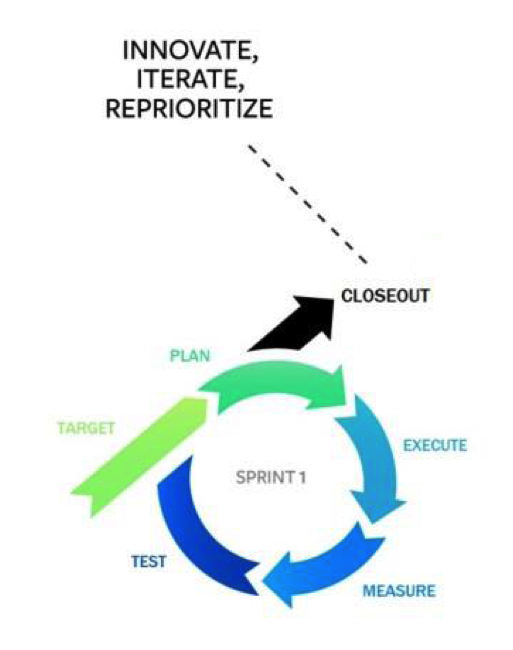How Agile Marketing Changes Your Link Building Process Forever
After a year of working in agile marketing, I can’t believe I ever used another process. Efficiency is increased. Morale is improved. Clients are happier. Links seem a little bit easier. Okay, the last one may be a bit of stretch — getting links is still hard. But the process of link building when you’re […]
After a year of working in agile marketing, I can’t believe I ever used another process. Efficiency is increased. Morale is improved. Clients are happier. Links seem a little bit easier.
Okay, the last one may be a bit of stretch — getting links is still hard. But the process of link building when you’re following agile marketing makes it less monotonous. Let’s take a look at the seven principles of agile marketing and how they’ll help you see link building in a whole new light.
Validated Learning Over Opinions & Conventions
Typical workflow processes are viewed in a linear fashion: before moving onto the next step, the first one is fully completed. We guess at the end result. For example: We’ll compile 100 potential link sources, and then we’ll reach out to all 100 of them. We assume at least 30% will get back to us.
Agile marketing works in a circular feedback loop. There’s no end, and there’s no beginning. Instead of basing our plan on opinions or things we learn from others — both of which are helpful — we learn what works best for this client at this time through hands-on implementation.
Customer-Focused Collaboration Over Silos & Hierarchy
We’ve talked a lot about how there are no such things as silos in this industry anymore. SEO, content, PR, social, outreach — the lines are blurred so much it’s hard to see where one ends and the other begins.
Agile marketing tells us to mingle the mix even more for best results. In larger companies, departments should work together because they’re all fighting for the same cause. In smaller companies, it’s more likely that the digital marketer is doing all of those things.
Adaptive & Iterative Campaigns Over Big-Bang Campaigns
Everyone knows what it feels like to get zero links. It sucks. Big time. But it sucks even more when you’ve poured months, or even just a month, of resources into something that just didn’t pan out like you expected.
Agile marketing says to start small. Got an idea? Great. Get the minimal viable product out and see how your users react. See what works and what doesn’t. Test and adjust while you’re working, not after the fact.
Instead of working against long-term marketing plans, agile marketing lets us work in shorter bursts called sprints, typically 30 days long. Within a sprint, you go through the entire lifecycle of a marketing strategy: targeting your users, planning your tactic, executing it, measuring what worked, and testing different variations.
The Process Of Customer Discovery Over Static Prediction
You can never predict how your customers will react to something. Just look at Coca-Cola’s America the Beautiful Super Bowl ad.
When they launched the content, they probably weren’t expecting the backlash it received from people calling the content offensive because the song wasn’t sung completely in English.
End users are complex creatures. Instead of predicting how they’re going to react, ask them. Things like interviews, surveys and focus groups help you better understand what your users want out of a piece of content and what influences them to make a purchase — or, even simpler, share it.
Flexible Vs. Rigid Planning

“Plans are nothing. Planning is everything.” Well said, Eisenhower. Well said.
When it comes to link building, saying there’s only one way to do it is short sighted. Plans are too static. The name itself implies that it’s immobile, set in stone. Planning is more, well, agile. Planning is a living and breathing action that requires constant integration (with other tactics), innovation and iteration.
Responding To Change Over Following A Plan
How many times have you gotten halfway through a link building plan and had something change? Your client changes priorities. You think of a better direction. Google updates an algorithm.
It happens. And that’s okay.
The only thing you can count on in any link building plan — in any marketing plan — is that something is going to change. Plan for that at the beginning so when something does change, you’re ready for it. You can reprioritize and readjust.
Many Small Experiments Over A Few Large Bets
A client signs on for a 6-month link-building retainer. Wouldn’t you rather execute a variety of tactics instead of putting all your eggs in one basket? Implementing smaller experiments not only increases your chances of success, but it shows the breadth of your skill set. Clients, or your boss, will see more value because you’re constantly tweaking things to see what works better.
What do you think about agile marketing? How can you fit these values into your link building process?
Opinions expressed in this article are those of the guest author and not necessarily Search Engine Land. Staff authors are listed here.
Related stories
New on Search Engine Land

